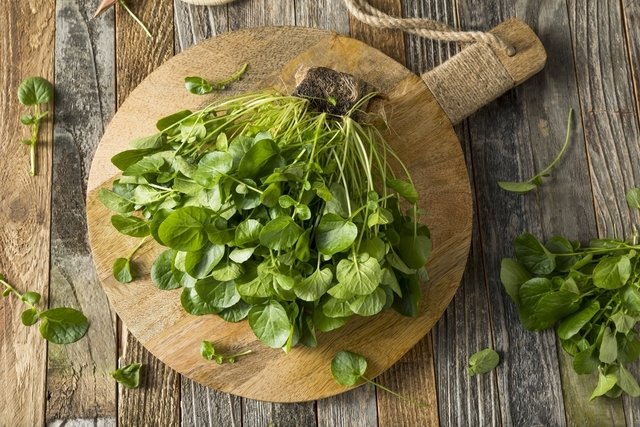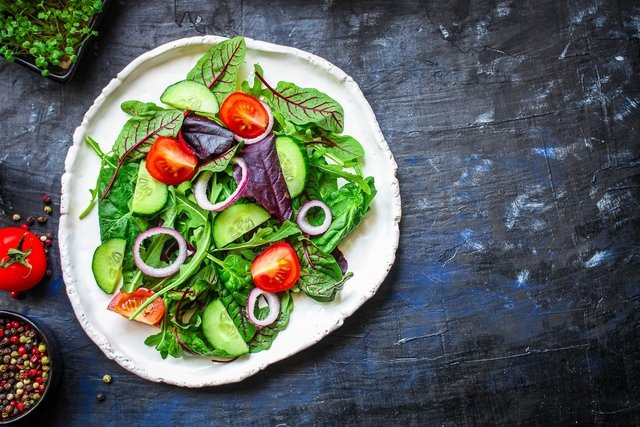Watercress is a vegetable that is rich in vitamin C, vitamin A and flavonoids, and compounds with anti-inflammatory properties. It contains antioxidants that fight free radicals and strengthen the immune system, which can be beneficial for treating health conditions like diabetes, high blood pressure or the flu.
Watercress is high in fiber, and therefore can keep you full and reduce overeating, which can lead to weight loss. This vegetable adds water and bulk to the stool, which can help with constipation.
Also recommended: 35 High Fiber Foods: Food List, Health Benefits & Recommendations tuasaude.com/en/high-fiber-foodsWatercress has a slightly spicy flavor and is generally found in grocery stores and farmer's markets. It can be consumed raw in salads, dips and juices, or cooked in stir-fries, stews, soups, omelets and rice. Watercress can also be used to prepare home remedies, such as teas and syrups.

Health benefits
The main health benefits of consuming watercress are:
1. Preventing diabetes
Because of its high fiber content, watercress helps to regulate blood sugar levels. This can prevent insulin resistance and diabetes, as well as manage blood sugar levels in those who already have diabetes.
2. Strengthening bones
Watercress is rich in vitamin K, a vitamin that is essential for the bone formation and strengthening. It can prevent osteoporosis and conditions such as falls and fractures. Read more about vitamin K and how it can benefit your health.
Watercress also has great amounts of calcium, a mineral that also plays role in bone formation and overall bone health.
3. Preventing cancer
Watercress helps to prevent some types of cancer, such as pancreatic, breast or colon cancer, because it contains great amounts of flavonoids, isothiocyanates and glucosinolates. These are bioactive compounds with powerful antioxidant action that fight free radicals and prevent the growth and spread of cancer cells.
4. Preventing premature aging
As it is a vegetable rich in vitamin C, an important vitamin for the production and absorption of collagen, watercress helps maintain skin elasticity, preventing wrinkles and premature aging.
Watercress is also rich in glucosinolates, which are bioactive compounds with powerful antioxidant action that fight free radicals, one of those responsible for damage to healthy skin cells.
5. Promoting eye health
Watercress contains excellent amounts of lutein and zeaxanthin. These are carotenoids typically found in the eyes that help to fight free radicals and protect the retina. These compounds are important for maintaining eye health and preventing conditions such as macular degeneration and cataracts associated with age.
6. Preventing cardiovascular diseases
Due to its fiber content, watercress helps reduce fat absorption in the gut, which can promote optimal cholesterol and triglyceride levels in the blood. This can prevent diseases such as atherosclerosis, heart attack, high blood pressure and fatty liver.
7. Strengthening the immune system
Watercress is rich in vitamin C, vitamin A and flavonoids, which are compounds with antioxidant and anti-inflammatory action. It can strengthen the immune system and help to fight viruses, bacteria and fungi that cause coughs, allergies, bronchitis, sinusitis and the flu.
8. Fighting constipation
Because it contains excellent amounts of fiber, watercress promotes water absorption in the gut. This can make stools softer and promote bowel movements, to help combat constipation.
9. Preventing bleeding
Vitamin K is naturally found in watercress in high quantities. It is an essential nutrient for maintaining normal blood clotting and preventing excessive bleeding with cuts and fractures.
10. Promoting weight loss
Watercress can help to promote weight loss, because it is a source of fiber that helps keep you full. This can help to reduce overeating throughout the day.
Furthermore, watercress is low in fat and calories, making it a great option to include in weight loss diets.
Nutritional information
The following table outlines the nutritional information of 100g of chopped, raw watercress, which is equivalent to 3 cups:
It is important to highlight that the above health benefits can be achieved when watercress is added to a balanced diet and an active lifestyle.
How to consume
Watercress can be consumed raw and added in salads, dips and juices, or cooked in stir-fries, stews, soups, omelets and rice.
Cooked watercress contains a higher level of carotenoids when compared to the raw version. However, antioxidant compounds such as glucosinolates and flavonoids are generally lost when over-cooked, which is why it should be avoided.
Watercress can also be used in teas or syrups to help treat phlegm or coughs.
- Watercress syrup: Blend 250 ml of pure watercress juice with 1 cup of honey, then pour in a pan and boil over low heat, until it has a viscous texture. After cooling, add 5 drops of propolis. Take 1 tablespoon of this syrup, 3 times a day, until phlegm improves.
- Watercress tea: Add 1/2 cup of chopped watercress leaves and stems to 150 ml of boiling water, cover and let the mixture infuse for 5 to 10 minutes. Strain, sweeten with 1 tablespoon of honey and drink 2 to 3 cups of this tea a day until your cough and phlegm improve.
Watercress can also be used to prepare a homemade syrup with turnip, pineapple and beetroot, which can help to reduce the symptoms of bronchitis and coughing.
Contraindications for use
Excessive intake of watercress can increase the risk of miscarriage and, therefore, pregnant women should not consume this vegetable in the form of teas or syrups.
Furthermore, watercress can interfere with the action of some medications, such as warfarin, lithium and chlorzoxazone. Therefore, you should speak to your doctor before taking watercress, especially if you are already taking medication.
Healthy recipes

Check-out some healthy watercress recipes that you can prepare at home:
1. Watercress juice
Ingredients:
- 2 stalks of watercress
- 200 ml of orange juice
- 5 drops of propolis
Directions:
Wash the watercress stalks well. Blend all ingredients in a blender and drink up to three times a day.
2. Watercress salad
Ingredients:
- ½ bunch of watercress
- ½ red onion
- 1 Italian tomato
- 1 pinch of salt
- Black pepper to taste
- 1 teaspoon of lemon juice
- 1 tablespoon of olive oil
Directions:
Wash the watercress leaves well, dry and place in a bowl. Chop the onion into thin slices and add to the watercress. Chop the tomato into cubes and transfer to the bowl. Season the salad with olive oil, salt, pepper, lemon juice and salt. Mix well and serve.
3. Sauteed watercress
Ingredients:
- 1 bunch of watercress
- ½ small chopped onion
- 1 clove of chopped garlic
- 1 chopped tomato
- 1 teaspoon of salt
- 1 tablespoon of olive oil
Directions:
Wash and dry the watercress leaves well. In a pot, heat the olive oil and sauté the onion and garlic over medium heat for 3 minutes. Add the watercress and stir, with a spoon, until the leaves become wilted. Add the tomato and salt, letting it cook for another 3 minutes, then serve.
4. Ricotta and watercress dip
Ingredients:
- ½ handful of watercress (chopped leaves only)
- ½ cup of cottage cheese
- 150 g of fresh ricotta
- ½ onion
- Black pepper to taste
- 2 garlic cloves
- juice of ½ lemon
Directions:
Wash and dry the watercress leaves well. Dice the onion and garlic. Place in a processor and blend until ground into small pieces. Add the watercress leaves and lemon juice and beat a little more, until smooth. Add the ricotta and beat a little more in the processor. Transfer the mixture to a bowl and add the cottage cheese and black pepper, mixing well with a spoon. Serve with toast or bread.
